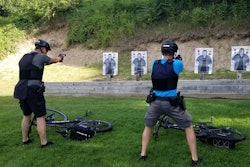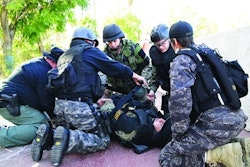Earlier this week, tragedy struck the Polk County (FL) Sheriff's Office when a deputy was fatally shot while assisting with a felony warrant service in an unincorporated area of Polk City.
According to a PCSO press release, Deputy Blane Lane was one of four members of the SO who arrived at a residence where a wanted female subject had been reported to be located. Deputies made contact with a witness at the scene who directed them to the rear of the building, where another witness indicated that the suspect was inside.
Three of the four entered the dwelling, with Deputy Lane taking up a tactical overwatch position outside that afforded him a view of the door and windows to ensure that he would see the suspect in the event she tried to flee.
When the three deputies encountered the subject pointed a realistic-looking replica firearm at them. The deputies then opened fire with their service weapons and at least one of their rounds exited the wall of the dwelling, striking Deputy Lane in the arm and shoulder.
Lane was transported to a nearby hospital where he later succumbed to his wounds.
This week's column is dedicated to the memory of Deputy Blane Lane, and written in hope for the healing for his family, friends, and fellow LEOs during this difficult time.
Thinking, Training, Preparing
One ugly reality of law enforcement is that several dozen officers are fatally shot every year. In the overwhelming number of cases, those killed by gunfire are shot by an unremorseful assailant whose intention at the time is to kill a cop.
It is incredibly rare that an officer is fatally wounded by what some in the media call "friendly fire"—there is nothing "friendly" about it. However, it happens, and when it does, everyone in the profession should take a moment to give to some thought to some difficult questions, the most important of which is, "What if this happened here?"
Law enforcement leaders—and trainers—across the country should look at the tragedy in Florida this week as an impetus to ask and answer that question (and others).
Street-level leaders—generally the Lieutenants and Sergeants—need to be aware of the fact that the dynamic between officers might change. There may be some interpersonal tensions where previously none had existed. Some people may exhibit resentment. Others may become withdrawn. One or more of the individuals directly involved with the incident may face administrative or even legal repercussions.
It's important to have people in place who are trained in some pretty heady mental health assistance capabilities—a run-of-the-mill peer-support group simply won't be sufficient.
Even if there is a really robust peer-support structure in place at your agency—one that regularly has to deal with the types of thoughts and feelings commonly occurring in people who have just endured a typical traumatic incident—it's entirely possible that the training they have doesn't include anything to prepare them for this type of ultra-low-frequency event.
A professional psychologist or psychiatrist will have the training necessary to recognize and appropriately respond to the types of anger, anxiety, defensiveness, depression, fear, guilt, grief and sadness someone might experience if they were directly involved in this type of incident.
Finally, remember that a fair number of officers are left with non-life-threatening wounds due to accidental shootings. The trauma for all concerned is measurably less, but that is not to say these incidents are without trauma. Preparation made any such potential eventuality is effort well spent.
















